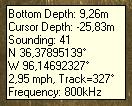
The demo file included with the LSV program is used.
Note that when opening a file the initial display shows the beginning of the file.
And the first Sounding number is 0 (zero).
In the other views (downscan) the first sounding is to the left.
And the newer added soundings are added to the right
(moving the image to the left).
Here are the other windows deleted - only the Sidescan view is shown.
The LSV is controlled via the play buttons

- or the drop down list under Sonar Chart called Position.

They perform the same functions - just different ways to control the viewer.
The display shows a portion of the recorded data where
the oldest recorded data is shown on the bottom line
while the newest recorded data is on the top line.
The oldest viewed Sounding number is shown in the header.

So that is the bottom line viewed.
When playing the next sounding just outside the viewed range is added at the top
and the bottom line is deleted from the view.
Thus the header will present the new bottom line - now with sounding nr 1.

If playing backwards (reverse play) the display will delete the top line
and fetch a a new older data for presentation on the bottom line.
Thus the bottom line will have a sounding number 1 lower than before.
Thus the sounding number presented in the header
allways will show the bottom line sounding number
- and that is the oldest dated presented sounding.
This has nothing to do with the play direction
- it just shows what sounding is at the bottom line!
Also regardless of the size of the window.
If one goes to the end of the file the header will show - not the last sounding - but the bottom line sounding.
The last record is on the top - remember?
The cursor can be used to present information about a specific point of the viewed data.
The data looks like this:

The data is relevant for the position of the mouse pointer.
Thus - moving the mouse one can get information about objects seen in the display.
Among others the relevant Sounding number.
Here is how to get info about a point

As seen the sounding number is 24 - not that far from the top.
Remember that the bottom line is the sounding nr 0
So we try another - now near the bottom

Ooops!
Notice that near the bottom we got a sounding number of 445 while we got sounding number 24 near the top.
And notice that the header sounding is 0 (zero)
- and that is the bottom line.
This clearly demostrates the bad behaivour of the sounding cursor data.
Since the viewed oldest data is at the bottom
and the newer viewed data adds on the top (at normal playing)
the highest viewed sounding number is on the top of the display.
Regardless of how the display is changed/played.
When playing normal the picture moves downwards while the new presented data adds on the top.
In ReversePlay the picture moves to the top and an older data line adds to the bottom.
But - the view allways will show the oldest presented data at the bottom.
The data fetched by the mouse is opposit to the displayed image.
We ask for data near the top - and got data near the bottom instead!
Thus the mouse data is not correlated with the displayed image.